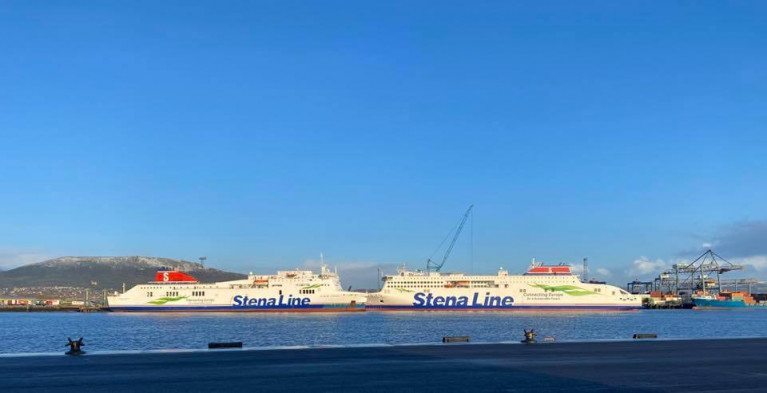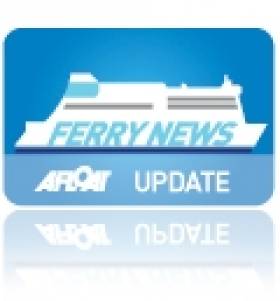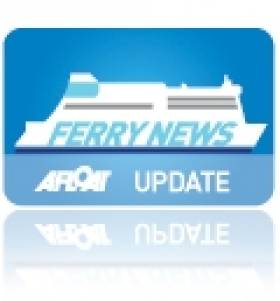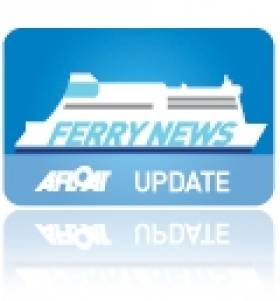Displaying items by tag: BelfastBirkenhead
A newly introduced freight-ferry for Stena Line’s Belfast-Birkenhead (Liverpool) route involved a ro-ro vessel make a maiden overnight crossing on the Irish Sea, writes Jehan Ashmore.
The 2,500 freight-lane metres capacity Stena Forwarder arrived in Belfast on 3 November and became the third vessel on the England-Northern Ireland route where passenger E-Flexer twins Stena Edda and Stena Embla have operated since 2020 and 2021 respectively.
Freight operations at Belfast use the Victoria Terminal (VT4) whereas passenger services are based at Victoria Terminal (VT2) but all vessels berth at the Twelve Quays terminal, Birkenhead, with up to tree departures daily and around 7 hours crossing time.
Only last month Stena Forwarder joined the Stena Ro Ro fleet and has been chartered to Stena Line’s Irish Sea operations on the Birkenhead-Belfast route. Formerly the Frijsenborg, as the 21,666 gross tonnage vessel had called to Belfast was renamed prior to entering service.
The Danish flagged vessel directly replaced Stena Foreteller which had been operating on the route’s shoulder service when engaged in un-accompanied freight on the Mersey-Lagan link. A sister, Stena Carrier given its size, made for quite an impression when as Afloat reported it call to Dun Laoghaire Harbour to undergo a survey in 2018.
Frijsenborg was built in 2016 at the Visentini shipyard in Italy from where the same shipbuilder launched a ropax also named Stena Forwarder which during the early 2000’s served on the Dublin-Holyhead route.
Stena Line operate other freight-only vessels on the Irish Sea, the twins Stena Hibernia and Stena Scotia on the Belfast-Heysham route, however the pair are to be replaced by the custom-built Stena NewMax methanol-fuelled ro-ro ferries due to enter service in 2025.
Boost in Freight Capacity As Stena Line Add Larger Ship on Belfast-Birkenhead (Liverpool) Route
Ferry company Stena Line has once again realigned its NI freight services to better reflect market demand created by Brexit related trade distortions.
To accommodate this change in demand, the operator has redeployed its larger Stena Foreteller ship to the popular Belfast-Birkenhead (Liverpool) route adding a much needed additional 13% freight capacity.
Freight routes between Britain and ROI have witnessed a decline of up to 25% whilst trade routes into Northern Ireland from Britain have seen month on month increases caused in the main by the impact of Brexit.
Paul Grant, Stena Line Trade Director (Irish Sea) commented: “We are seeing a prolonged distortion of the market in terms of the preferred freight routes between Britain and the island of Ireland. This presents an ongoing challenge for the entire logistics industry to keep pace with shifting demand and preferences.
“As the largest ferry network operator on the Irish Sea, providing ten ships and five routes between Britain and the island of Ireland, Stena Line is uniquely placed to respond quickly to changing customer demands which is why we have redeployed the Stena Foreteller to operate on the Belfast-Liverpool service. We now have seven ships dedicated to our Belfast hub.”
Paul Grant added: “The popularity of the Belfast-Liverpool freight service continues to grow which is why we took the decision two years ago to invest in the route by increasing capacity (at the time) by 25% with the introduction of two brand new e-Flexer vessels. Despite that upweighting, demand still continues to grow hence our recent additional capacity adjustment in the form of Stena Foreteller"
"It remains to be seen to what extent the current market distortions will become a permanent feature of trade between Britain and the island of Ireland but from Stena Line’s perspective, we will continue to listen to our customers and provide our freight capacity to where it is most needed.”
Brand New Stena E-Flexer Completes Maiden Delivery Voyage to Belfast Harbour
The brand new 'next generation' ropax ferry Stena Edda for the first time arrived into Belfast Harbour this morning following a 10,500 mile delivery voyage from China, writes Jehan Ashmore.
Afloat also tracked the Chinese built Stena Line E-Flexer ropax class yesterday at anchor in Belfast Lough having sailed up the Irish Sea. Following an overnight anchorage the 40,000 gross tonnage ferry made a maiden arrival in Belfast Port this morning having docked at the VT2 terminal for berthing trials.
Stena Edda is understood to enter the Belfast-Birkenhead (Liverpool) route next month and will become amongst the most environmentally sustainable vessels in the Irish Sea. At 215 metres in length, Stena Estrid is larger than today’s standard ropax vessels, with space to carry 120 cars and 1,000 passengers, and a freight capacity of 3,100 lane meters. This will be a boost to the route as there is a 50 per cent increase in freight tonnage.
Introduction of Stena Edda will also result in the direct replacement of Stena Lagan. In addition another new sister, Stena Embla is also to debut on the Irish Sea route ultimately leading in the withdrawal of the route's second ship sister, Stena Mersey.
In order to accommodate the E-Flexers, a new double tier berth linkspan has been installed in Belfast Harbour. While in Birkenhead, further adaptive works as Afloat previously reported began at the Twelve Quays River Terminal on Merseyside. The route is the longest on the Irish involving a 8-hour passage time.
Already in service on the Irish Sea is the leadship of the E-Flexer class, Stena Estrid which entered on the Dublin-Holyhead route last month.
Freight Service One Year On Also Brings Port Improvements
#FreightFerry – Belfast-Birkenhead (Liverpool) freight-ferry Stena Hibernia, which has been in service for just over one year, has according to Stena Line attracted freight traffic despite the difficult Northern Ireland market, writes Jehan Ashmore.
The ro-ro freight ferry has a capacity for 12 drivers and 110 unaccompanied units representing an additional 1,680 lane metre capacity. The route is also served by a pair of ro-pax ferries Stena Lagan and Stena Mersey.
Stena Hibernia operates eight sailings per week and to a sailing schedule that has enabled customers to deliver on next-day orders.The service has also further developed the positions of the Port of Liverpool and Port of Belfast as freight hubs.
Following negotiations between Stena Line and Belfast Harbour, additional quay space is for the Victoria Terminals (VT1 and 2) and Holyhead so to improve the overall operating layouts of these ports.
Relief Ferry Stands In for Stena’s Belfast-Birkenhead Route Refit of Ro-Pax Sisters
#Relief-Ferry – Stena Line has confirmed to Afloat.ie that ro-pax ferry, Stena Feronia is providing relief cover for Belfast-Birkenhead (Liverpool) route sisters Stena Lagan and Stena Mersey during the pairs annual winter refit programme, writes Jehan Ashmore.
Currently, Stena Mersey is undergoing dry-docking at Harland & Wolff Heavy Industries, where the Belfast ship-repair and marine engineering business almost directly faces opposite VT2.
Victoria Terminal 2 is where Stena Line has its Laganside located operations that run to Merseyside. Also operating from the downriver Belfast Lough terminal is a newer route to Cairnryan on Loch Ryan in Scotland.
At this stage, Stena Line has not yet confirmed all of the dry docking yards, but H&W will be utilised for a number of vessels. Following the 'Mersey's refit her sister (see photo and report), will occupy the drydock at Queens Island.
The Irish Sea sisters and likewise of stand-in ship Stena Feronia were built by Visentini shipbuilders, the Italian yard having also rolled out several variants of their own ro-pax designs.
Notably, the yard's ubiquitous ro-pax design is for example Stena Horizon, the former Celtic Link Ferries chartered vessel Celtic Horizon. The final CLF sailings took place at the end of March, for a farewell voyage report here.
She continues running Rosslare-Cherbourg sailings since Stena Line acquired the Wexford based business. This is the new owners first ever ferry service linking Ireland and Europe.
For a photo of the pierhead at Rosslare Europort, taken from onboard Celtic Horizon, click here also for previous report on the issue of sand building up at the breakwater. The sands accummulated from storms early this year and dredging works are due to start tomorrow.
Stena Line Record Uplift on Belfast-Birkenhead Route
#ROUTE BOOST- Since Stena Line took over the Belfast-Birkenhead (Liverpool) route and two ro-pax ferries last summer, passenger figures have increased, according to PlaceNorthWest.
In June 2012 volumes were up across all measures compared to the same month last year with passenger vehicles recording: 7,577 (2011: 6,773), car passengers: 15,838 (14,342) and foot passenger figure of 2,473 (2,276).
Richard Horswill, Route Director for the route said "A like-for-like monthly comparison between June 2011 and June 2012 shows an increase across the board in vehicles, car and foot passengers travelling on the route.
This is as a direct result of the investment over the last number of months with the £4m refurbishment of the Stena Mersey and Stena Lagan as well as a focus on customer services.
#STENA 50TH ANNIVERSARY – In this 50th anniversary year of Stena Line, the Swedish owned ferry operator has 19 routes stretching from Belfast to Scandinavia. This is set to further expand as Stena have secured approval by German competition authorities to acquire Scandlines, a rival German ferry firm running in the Baltic Sea, writes Jehan Ashmore.
In the deal which is to be finalised in August, Stena Line are take-over five routes and two ships from Scandlines. The routes are mostly freight-orientated services to Germany, Sweden and Latvia would accelerate Stena's position in one of Europe's fastest growing short-sea shipping markets.
Incidentally the Scandlines ferry 'Sassnitz' (1989/21,154grt) featured on last Sunday's BBC One British version of the popular Swedish police drama series 'Wallander'. The vessel operates from Sassnitz in Germany to Trelleborg near Ystad, where the drama is set and in which detective Kurt Wallander is played by Belfast-born Kenneth Branagh who won a BAFTA in 2010 for the leading-role.
It was in Belfast last year that saw several developments by Stena Line taking place, notable the acquisition of DFDS Seaways Irish Sea operations which included the freight-only Belfast-Heysham and Belfast-Birkenhead (Liverpool) routes. Following this was the launch in November of two 'Superfast' ferries onto the new Belfast-Cairnryan route.
This is new territory as Stena have never operated from the Mersey on the 8-hour crossing which also operates night sailings. The route is another first for Stena on the Irish Sea, which is been marketed as one of their 'Overnight Superferry' routes, however they similarly market other routes being: Harwich-Hook van Holland, Frederikshavn-Oslo, Gothenburg-Kiel and Karlskrona-Gdynia.
As part of the deal with DFDS the 27,000 tons ro-pax sisterships Lagan Seaways and Mersey Seaways would remain on the route, as an existing charter arrangement had still to run its course.
To reflect the change of ferry operator, the sisters were renamed Stena Lagan and Stena Mersey and by the end of March this year both of the 980-passenger / 2,662-vehicle deck lane metre capacity vessels, underwent each a £1.5m internal refurbishment at Harland & Wolff and external painting.
The upgrade saw passenger facilities greatly improved compared to a somewhat spartan interiors as prescribed when the ships were completed by Italian shipbuilder Visentini. Since the vessels return to service the pair have been purchased from the charterer by Stena RoRo, the Gothenburg based charter division of Stena Line.
In essence this means that should further refurbishment of Stena style passenger facilities be planned, they can now be carried out without limitations imposed by the previous charter-owners.
#FERRY NEWS – A £4m upgrade of Stena Line's Belfast-Birkenhead (Liverpool) sisters has been completed at Harland & Wolff. The work was carried on the pair of 27,000 tonnes ships by Newry based specialist marine outfitters MJM Marine, writes Jehan Ashmore.
Work on the 980-passenger vessels Stena Mersey and Stena Lagan began in March and ended last month. During that timeframe the Stena Feronia which was in a collision with a cargoship in Belfast Lough, was deployed to cover the overhaul of the sisters, now sporting Stena Line livery.
The investment programme introduced on board entails facilities such as a lounge pod-area featuring several iMacs, a trucker's lounge, free wi-fi and a bar & grill and a restaurant.
In addition the refurbishment has improved customer experience with the inclusion of an improved shop, improved guest services, and cinema offering guests free movies during the north Irish Sea crossing.
The pair built by Visentini, the Italian shipbuilder based near Venice, can handle 2,662 freight lane metres are now owned by a subsidiary of Stena Line, in the form of Stena RoRo which purchased the vessels from a German bank.
Beforehand the ferries were part of Epic Shipping which chartered them in turn to DFDS Seaways. The Danish owned operator's short-lived Irish Sea route network venture was sold last year to Stena which included the sisterships.
Stena RoRo also purchased the Visentini built ro-pax Watling Street and also from the same yard the former Celtic Link ro-pax Norman Voyager, which is currently back on its original Portsmouth-Le Havre route running on charter to French ferry operator LD Lines.
Meanwhile Celtic Link's existing Rosslare-Cherbourg route vessel Celtic Horizon, is on a five year charter from an offshoot of the same Italian shipbuilder and again is another vessel of the successful ro-pax design.
Irish Sea Ferry Deal Under Review
Stena Line's acquisition of DFDS Seaways Irish Sea services in December, has now been referred to the UK's Competition Commission by the Office of Fair Trading (OFT).
The £40m ferry deal for two routes, Belfast-Birkenhead (run by two chartered ro-pax ferries) and the Belfast-Heysham freight-only service, included two 114-trailer capacity vessels.
The Competition Commission is expected to submit its findings by the end of July while the Irish Competition Authority is also still investigating the merger. To read more about this, click the BBC report here.




































































